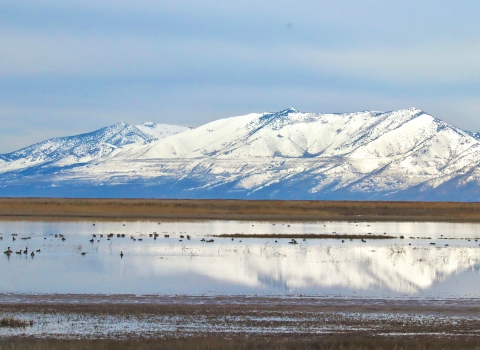SMYRNA, Del. — U.S. Fish and Wildlife Service Director Martha Williams today unveiled the rehabilitated Bombay Hook National Wildlife Refuge Visitor Center, which is replacing the deteriorating facility with a smaller multipurpose building that will help connect people to nature and engage local communities in the Service’s conservation mission.
“Projects like Bombay Hook National Wildlife Refuge’s Visitor Center illustrate how the Great American Outdoors Act is increasing outdoor recreation opportunities and enhancing people’s experiences in nature," said U.S. Fish and Wildlife Service Director Martha Williams. “It is exciting to see this innovation in action, where sustainable buildings in harmony with the environment ensure all people have the chance to connect with the natural world.”
Williams was joined by U.S. Sen. Tom Carper, Service staff and partners to celebrate the rehabilitated Bombay Hook National Wildlife Refuge Headquarters and Visitor Center, supported by funds from the Great American Outdoors Act.
This priority GAOA project replaces multiple existing Coastal Delaware Refuge Complex facilities and will retire nearly $5.5 million in deferred maintenance. The center will serve as a workspace for employees across multiple Service programs and a facility for welcoming the public. It is expected to be complete and open to the public by late 2024.
The environmentally friendly, energy-efficient building was constructed with conservation in mind, complete with electric vehicle charging stations, solar panels and other features that meet the U.S. Green Building Council’s LEED Silver certification for sustainable design. The facility also is fitted with bird-friendly window treatments, installed as part of the Service’s commitment to reducing bird strikes at its facilities.
The GAOA established the National Parks and Public Land Legacy Restoration Fund, a bipartisan investment that improves visitor experiences, bolsters climate resilience, and invests in the economy by creating good-paying jobs at national wildlife refuges and on other public lands. The fund provides the Service $95 million annually to address deferred maintenance needs throughout the National Wildlife Refuge System. Since 2020, the act has funded 35 projects on 28 national wildlife refuges across the country.
AOA’s LRF funding sunsets after fiscal year 2025 and would need to be reauthorized by Congress to continue the efforts underway to address significant infrastructure needs across public lands.
Through this funding, the Service has made significant progress repairing infrastructure and public-use facilities as well as improving visitor centers, roads and trails. These enhanced recreation opportunities nationwide ensure world-class, safe and welcoming experiences for visitors, regardless of age or ability.
Work funded through the GAOA is advancing the Biden-Harris administration's America the Beautiful initiative by making public lands more resilient to climate change climate change
Climate change includes both global warming driven by human-induced emissions of greenhouse gases and the resulting large-scale shifts in weather patterns. Though there have been previous periods of climatic change, since the mid-20th century humans have had an unprecedented impact on Earth's climate system and caused change on a global scale.
Learn more about climate change through improvements like erosion reduction and shoreline stabilization and boosting local economies.
Bombay Hook National Wildlife Refuge is a destination refuge, welcoming more than 110,000 visitors each year to enjoy hiking, biking, photography and some of the best birdwatching on the East Coast.
-FWS-
The U.S. Fish and Wildlife Service works with others to conserve, protect and enhance fish, wildlife, plants and their habitats for the continuing benefit of the American people. For more information, visit www.fws.gov and connect with us on social media: Facebook, Instagram, X (formerly known as Twitter), LinkedIn, Flickr and YouTube.



